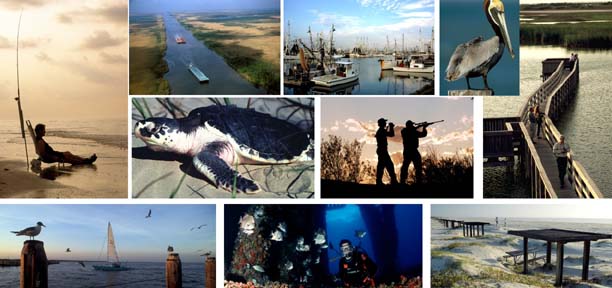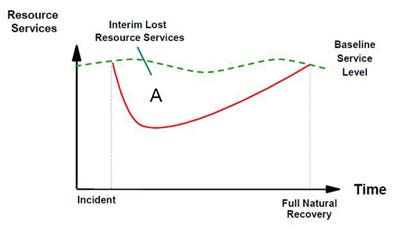Natural Resource Damage Assessment FAQ
- What is NRDA?
- What are Natural Resources?
- Who are the Natural Resource Trustees?
- What is the Trustees Role?
- How is NRDA a cooperative process?
- What happens after an oil spill or a release of a hazardous substance?
- What is NRDA Restoration?
- What is Emergency Restoration?
- What is Primary Restoration?
- What is Compensatory Restoration?
What is NRDA?
A Natural Resource Damage Assessment (NRDA) is a legal process under state and federal laws to determine the type and amount of restoration needed to compensate the public for harm to natural resources and their human uses that occur as a result of an unauthorized release of hazardous substances or oil. The NRDA process brings together technical and legal teams of natural resource trustees to complete the following objectives authorized under the Clean Water Act, the Oil Pollution Act, the Comprehensive Environmental Response Compensation, and Liability Act, the Texas Water Code and the Texas Oil Spill Prevention and Response Act:
• Assess natural resource injuries and lost services caused by oil spills or hazardous substance releases.
• Determine the appropriate type and amount of restoration needed to compensate the public for these injuries and lost services.
• Ensure that responsible parties implement or fund the appropriate restoration activities to compensate the public.
What are Natural Resources?
Natural resources are the land, fish, wildlife, biota, air, water, groundwater, drinking water and other resources that are controlled or managed by federal or state governments or Indian Tribes.

Who are the Natural Resource Trustees?
The natural resource trustees are the designated federal, state and tribal agencies who are responsible for the natural resources impacted by an oil spill or hazardous substance release. Federal trustees are designated by the President; state trustees are designated by governors; tribal trustees are designated by the governing bodies of recognized tribes. Three Texas state agencies have been designated to protect, conserve and restore Texas natural resources impacted by oil and hazardous substances. They are the Texas General Land Office (GLO), the Texas Commission on Environmental Quality (TCEQ) and the Texas Parks and Wildlife Department (TPWD).
Texas state trustees work in a partnership with federal trustee agencies; generally the National Oceanic and Atmospheric Administration (NOAA) on behalf of the United States Department of Commerce, and the United States Department of the Interior (DOI), as represented by the United States Fish and Wildlife Service (FWS) and National Park Service (NPS). The state and federal trustees in Texas recognize that they have common interests in sharing information, ideas and expertise necessary to compensate the public for harm to natural resources as a result of oil spills and hazardous substance releases. To serve those common interests, the trustees entered into a Memorandum of Agreement (MOA) and formed the Texas Trustee Council to promote communication, coordination and cooperation among the trustees throughout the natural resource damage assessment and restoration process.
What is the Trustees Role?
The trustees protect and restore the natural resources of Texas, including migratory birds, fish, endangered species and their habitats. The trustees also seek compensation for the lost public use resulting from injured natural resources, especially those associated with lost recreational fishing and hunting opportunities as well as public visitation.
How is NRDA a cooperative process?
The trustees work cooperatively with each other and, when possible, the parties responsible for the spill. The damage assessment process promotes cost-effective assessment and restoration - benefiting the public, the responsible parties, and the environment.
What happens after an oil spill or a release of a hazardous substance?
During and after a spill or release, there are three main components to restore impacted areas:
- Preassessment: Determine whether injury to natural resources has occurred. Work includes collecting time-sensitive data, reviewing scientific literature about the type of oil spilled or the hazardous substances released, and determining the types of injuries that may have occurred.
- Injury Assessment and Planning: Perform scientific and economic studies to assess and quantify the injuries and the loss of services. A restoration plan is developed to identify restoration projects that will offset the level of injury.
- Restoration: Work with the public and responsible party to select, implement, and monitor restoration projects. The responsible parties pay for all assessment and restoration costs.
What is NRDA Restoration?
 NRDA restoration means any action, or combination of actions, to restore, rehabilitate, replace, or acquire the equivalent of injured natural resources and services to baseline or the condition they were in before the spill or release. Examples include preserving critical habitat, constructing wetlands, and improving recreational opportunities on State Parks.
NRDA restoration means any action, or combination of actions, to restore, rehabilitate, replace, or acquire the equivalent of injured natural resources and services to baseline or the condition they were in before the spill or release. Examples include preserving critical habitat, constructing wetlands, and improving recreational opportunities on State Parks.
What is Emergency Restoration?
Emergency restoration includes actions that are taken prior to the completion of the damage assessment and restoration planning process to prevent or reduce continuing natural resource injuries and/or avoid a potential loss of natural resources or their services. Trustees may take emergency restoration actions that are feasible, likely to minimize continuing or prevent additional injury, and can be conducted at a cost that is not unreasonable. Although emergency restoration actions may be considered and implemented by trustees at any time throughout the NRDA, typically trustees begin evaluating the need for emergency restoration during the response phase. Examples of emergency restoration include re-planting submerged aquatic vegetation killed by prop scars, revegetating wetland shorelines to prevent further erosion, and closing the fishing season to allow species to recover.
What is Primary Restoration?
Primary restoration includes actions conducted by trustees to return injured natural resources to the condition that would have existed if the spill or release had not occurred. Some natural resources might recover very slowly, or not even recover at all, from injuries due to a spill or release. Trustees are authorized to conduct primary restoration to speed the recovery of the injured resources, such as reconstructing physical habitat that was destroyed or taking measures to protect or increase the population of an endangered species.
What is Compensatory Restoration?
Compensatory restoration includes actions conducted by the trustees to address the natural resource injuries and services lost that accrue from the date of injury until recovery to pre-spill or pre-release conditions is completed. While the resource is impaired, it is unable to provide services upon which other parts of the ecosystem and the public rely. Trustees are authorized to ensure that compensatory restoration projects are implemented to compensate the public for these interim losses.